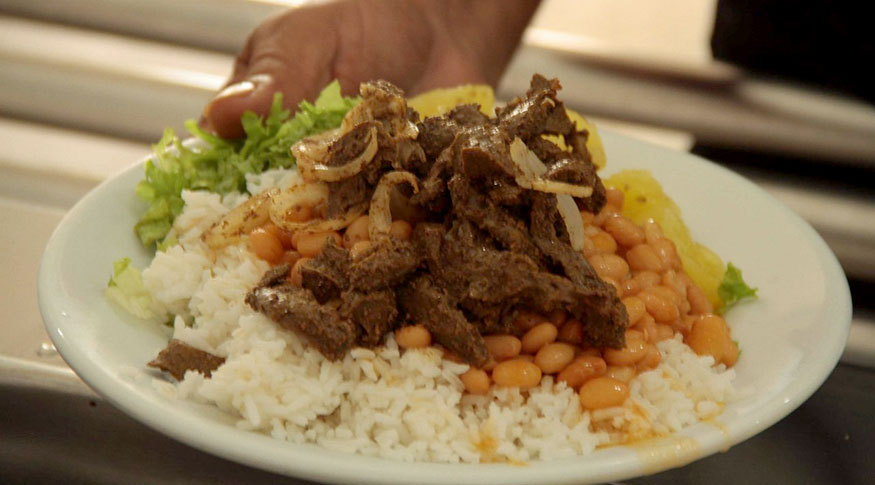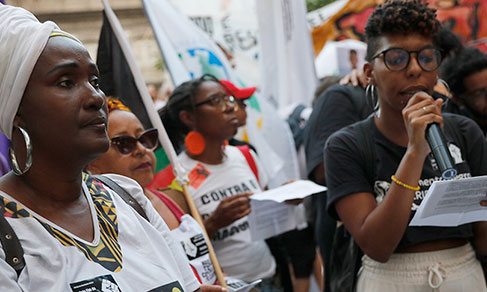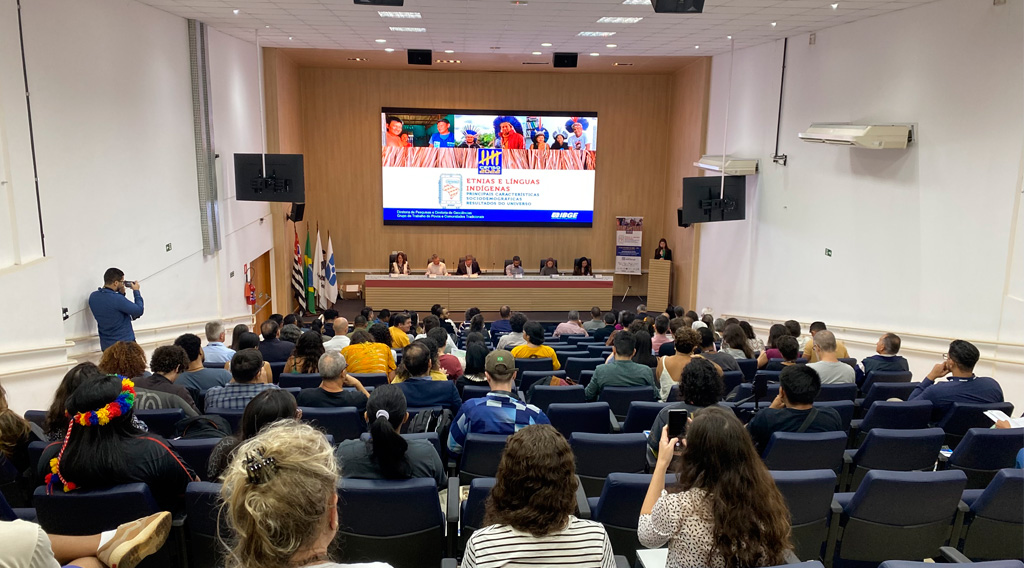Continuous PNAD
Food security in Brazilian households increases in 2023
April 25, 2024 10h00 AM | Last Updated: April 30, 2024 05h34 PM
Highlights
- In Q4 2023, having as a reference the three months prior to the data of the survey, 72.4% (or 56.7 million) of the households in Brazil were food secure, according to the Continuous PNAD’s Food Security module.This proportion increased by 9.1 percentage points (p.p) against the latest IBGE survey on this topic, POF 2017-2018, which had counted 63.3% households in Brazil as food-secure.
- In Brazil, 27.6% (or 21.6 million) of the households were food-insecure in 2023, with mild food insecurity in 18.2% (or 14.3 million), moderate food insecurity in 5.3% (or 4.2 million) and severe food insecurity in 4.1% (or 3.2 million) of them.
- POF 2017-2018 had found 36.7% of the housing units in the country facing food inecurity, with mild food insecurity in 24.0%, moderate food insecurity in 8.1%, and severe food insecurity in 4.6% of them.
- The proportion of housing units facing moderate or severe food insecurity hit 9.4% in 2023, having decreased by 3.3 percentage points (p.p.) from POF 2017-2018 (12.7%), and even more (1.6 p.p.) against PNAD 2013 (7.8%).
- The proportion of severely or moderately food insecure households in urban areas in 2023 (8.9%) was below that in rural areas (12.7%). However, this percentage of rural areas was the lowest in the series of IBGE surveys investigating this topic, a series initiated by PNAD 2004 (23.6%).
- The North (60.3%) and Northeast Regions (61.2%) had the smallest proportions of food-secure housing units, whereas the Central West (75.7%), Southeast (77.0%) and South (83.4%) had the highest percentages.
- In 48.3% of the households in the country, the persons in charge was a man, and in 51.7% of them, a woman. Nevertheless, among food-insecure households, 59.4% were female-headed and 40.6%, male-headed, a difference of 18.8 p.p.
- And 42.0% of the households in Brazil were headed by a white person; 12.0% of them, by a black person, and 44.7% of them, by a brown one. And 42.0% of the households in Brazil were headed by a white person; 12.0% of them, by a black person, and 44.7% of them, by a brown one.
- In half of the severeley or moderately food-insecure households (50.9%), per capita household income was below half a mininum wage.

In Q4 2023, having as reference the three months prior to the date of the survey, 72.4% (56.7 million) of the 78.3 million permanent private housing units in Brazil were food secure, that is, they had permanent access to adequate food. This proportion increased by 9.1 percentage points (p.p.) against the latest IBGE survey on this topic, POF 2017-2018, which had counted 63.3% of the households in Brazil as food-secure.
Nevertheless, 21.6 million households (27.6%) were affected by food insecurity at some level. The most severe form affected about 3.2 million households (4.1%). The data come from the Food Security module of the Continuous National Household Sample Survey - Continuous PNAD, released today (25) by the IBGE.
The result of a partnership between the IBGE and the Ministry of Development and Social Assistance, Family and Hunger Combat, this survey adopted as its methodological framework the Brazilian Food Insecurity Scale (EBIA), which allows identification and classification according to levels of food insecurity of households and their residents. This is the first time Continuous PNAD Contínua makes available results based on EBIA criteria, but four previous publications by the Institute had used this scale to study the topic: Extra modules on Food Security and Nutrition (SAN), within PNADeditions in 2004, 2009 and 2013, and the Consumer Expenditure Survey (POF) 2017-2018.
The proportion of food-secure households had reached its peak in 2013 (77.4%), but fell in 2017-2018 (63.3%). “After a trend to increase in food security in the years of 2004, 2009 and 2013, the data generated by POF 2017-2018 were characterized by the decrease in the predominance of permanent private households with access to adequate nutrition for residents. In 2023, the opposite took place, that is, there was an increase in the proportion of food-secure households, and a derease in the proportion of all food insecurity levels,” André Martins, manager of the survey, explains.
In the last quarter of 2023, 27.6% (21.6 million) of the private households in Brazil were food–insecure to a certain extent, with 18.2% (1.,3 million) being mildly food-insecure; 5.3% (4.2 million), moderately food-insecure and 4.1% (3.2 million), severely food-insecure. The proportion of moderately or severely food insecure housing units (9.4%) decreased by 3.3 percentage points (p.p.) from POF 2017-2018 (12.7%), but is still 1.6 p.p. above the result in PNAD 2013 (7.8%).
Severe food insecurity was the most significant in the rural areas of the country. The proportion of private hosuseholds regarding moderate or severe food insecurity in these areas reached 12.7%, against 8.9% in urban areas. In spite of that, the percentage recorded in rural areas was the lowest since PNAD 2004 (23.6%).
A comparison of data found in the Food Security module of Continuous PNAD in Q4 2023 and of POF 2017-2018 showed a drop of 25.0% in the number of housing units facing mild food insecurity. Against 2004 and 2009, the percentage of mild food insecturity was almost the same. In the last five years, between 2018 and 2023, there was a slight decrease in the prevalence of moderate food insecurity and a continuation of severe food insecurity at the same level.

Food insecurity is more prevalent in the North and Northeast Regions
In spite of having more them half of the residents with full and regular acess to food, considering both qualitative and quantitative aspects, the North (60.3%) and Northeast (61.2%) had the lowest proportions of food-secure households. These figures correspond, in number of households, to 3.6 million in the North and 12.7 million in the Northeast.
The South was the Major Region with the highest percentage of food-secure households (83.4), a total of about 9.7 million. In the Central West (75.7%) and the Southeast (77.0%) significantly more than half of the households were food secure.
The food-insecurity status was observed in approximately ¼ of the private households in the North (23.7%) and Northeast (23.9%), indicating a big number of residents being worried or uncertain about the access to food, which can interfere with the quality of their diet and the food sustainability of the family.
The proportions of moderate and severe food insecurity were also higher in the North and Northeast. The North (7.7%) had about four times more households facing severe food limitation, that is, severe food insecurity, against the South (2.0%). The North, Northeast and Central West were the Major Regions with the highest percentages of private households, with prevalence figures of 7.7%, 6.2% and 3.6%, respectively.
“On the other hand, severe food insecurity was observed in less than 5% of the households in the Southeast (2.9%) and South (2.0%). These pieces of information show that regional inequalites of access to food observed in PNADs of 2004, 2009 and 2013, and in POF 2017-2018, remained present in Continuous PNAD 2023 and that food insecurity remains concentrated in the North and Northeast,” the survey manager observes.
In 2023, Pará was the state with the biggest proportion of severely or moderately food insecure households (20.3%), one out of every five households, being followed by Sergipe (18.7%) and Amapá (18.6%). On the other hand, Santa Catarina (3.1%), Paraná (4.8%), Espírito Santo (5.1%) and Rondônia (5.1%) had the lowest percentages. At national level, 9.4% of the severely or moderately food-insecure household.

Men and white persons were the majority among heads of food-secure households
Considering the profile of the head of household, although the participation of women (51.7%) in the population overall exceeded that of men (48.3%), that order is reversed when food security if considered (48.7% versus 51.3%). Considering food insecure households alone, 59.4% were headed by women. Regarding food insecurity levels, moderate fodd insecurity was the type recording the biggest difference, 21.2 p. p. (60.6% and 39.4%, respectively).
By color or race, 42.0% of the heads of household were white; 12.0% black and 44.7% were brown. Within the food insecurity context, 29.0% were headed by white persons; 15.2% by black persons and 54.5%. by brown persons. In households facing severe food insecurity, the presence of households headed by a brown person increases to 58.1%, more than half of the share of households headed by white persons (23.4%).
The Food Security module of Continuous PNAD relative to Q4 2023 also showed an oppositte relation between the level of education of the head of household and the level of food insecurity. Households headed by persons with a low level of education tended to have a higher prevalence of food insecurity.
More than half (52.7%) of the food insecure households were headed by persons with a lower level of education (complete primary education, at most), whereas 7.9% of these households were headed by a person with a higher education degree. Among severely food insecure households, 67.4% were headed by persons without schooling or with incomplete primary education, whereas in 2.9% heads of household were persons with a higher education degree.
| Distribution of permanent private households, by food security status of the household, by some characteristics - Brazil - 2017-2018 | ||||||
|---|---|---|---|---|---|---|
| Some characteristics | Distribution of permanent private households (%) | |||||
| Total | Food security status of the household | |||||
| Food secure | Food insecure | |||||
| Total | Mild | Moderate | Severe | |||
| Total | 100,0 | 100,0 | 100,0 | 100,0 | 100,0 | 100,0 |
| Number of residents | ||||||
| Up to 3 | 73,2 | 75,3 | 67,5 | 65,4 | 70,2 | 73,0 |
| 4 - 6 | 25,7 | 23,8 | 30,5 | 32,8 | 27,6 | 24,3 |
| 7 or more | 1,2 | 0,9 | 2,0 | 1,7 | 2,2 | 2,6 |
| Head of Household | ||||||
| Sex | ||||||
| Man | 48,3 | 51,3 | 40,6 | 40,8 | 39,4 | 41,4 |
| Woman | 51,7 | 48,7 | 59,4 | 59,2 | 60,6 | 58,6 |
| Color ou race | ||||||
| White | 42,0 | 46,9 | 29,0 | 31,4 | 25,0 | 23,4 |
| Black | 12,0 | 10,7 | 15,2 | 14,7 | 16,3 | 16,5 |
| Brown | 44,7 | 41,0 | 54,5 | 52,7 | 57,6 | 58,1 |
| Level of education | ||||||
| No schooling | 5,6 | 4,7 | 7,7 | 6,2 | 9,1 | 12,6 |
| Incomplete primary education or equivalent | 27,6 | 24,3 | 36,3 | 32,7 | 41,3 | 46,0 |
| Complete primary education or equivalent | 7,7 | 7,3 | 8,7 | 8,7 | 8,8 | 8,8 |
| Incomplete high school or equivalent | 5,6 | 5,0 | 7,1 | 7,2 | 7,2 | 6,4 |
| Complete high school or equivalent | 30,2 | 30,6 | 29,2 | 31,9 | 26,3 | 21,2 |
| Incomplete higher education or equivalent | 4,3 | 4,7 | 3,1 | 3,5 | 2,5 | 2,1 |
| Higher education degree | 19,1 | 23,4 | 7,9 | 9,8 | 4,9 | 2,9 |
| Employent category and type | ||||||
| Domestic worker | 4,4 | 3,5 | 6,7 | 6,5 | 7,6 | 6,6 |
| Worker in the private sector with a formal labor contract | 20,5 | 22,8 | 14,4 | 16,7 | 11,3 | 8,2 |
| Worker in the private sector without a formal labor contract | 6,7 | 6,1 | 8,2 | 8,4 | 7,8 | 8,1 |
| Workerin the public sector (including statutory civil servants and the military) | 7,9 | 9,1 | 4,6 | 5,5 | 3,3 | 2,1 |
| Self-employed | 17,5 | 17,7 | 17,1 | 17,7 | 16,1 | 15,6 |
| Employer | 3,1 | 3,9 | 0,9 | 1,1 | 0,5 | 0,3 |
| Other | 40,0 | 36,9 | 48,2 | 44,2 | 53,5 | 59,1 |
| Source: IBGE, Diretoria de Pesquisas, Coordenação de Pesquisas por Amostra de Domicílios, Pesquisa Nacional por Amostra de Domicílios Contínua 2023 | ||||||
The job of the head of household was another factor related to the change in the proportion of food secure households. Households headed by domestic workers represented 3.5% of the food secure ones, and were 4.4% of the total households.
Employment formality had a significant impact on the capacity of guaranteeing the acquisition of food in households, as 22.8% of the households were food secure when headed by persons with a formal employment contract in the private sector, a higher percentage than that observed in the households overall (20.5%). Workers in the private sector without a formal contract headed 6.1% of the food secure households, and 6.7% of the households overall. As for severely food insecure households, 6.6% were headed by domestic workers and 8.1% by workers without a formal employment contract.
The survey also showed that 4.5% of the population aged zero to four, and 4.9% of the population aged five to 17 faced severe food insecurity. However, in the population aged 65 and over this proportion was 2.8%. So, considering the distribution of residents by age, and by food security status of the household, there was more vulnerability to food restriction in households inhabited by children and/or teenagers. As age increased, so did the proportions of those living in food secure households, with the subsequent decrease of the proportion of residents facing different levels of food insecurity.
Half of the severely or moderately food insecure housing units had per capita household income below half a minimum wage
As for income, 50.9% of the moderately or severely food insecure households had per capita household income below half a minimum wage.
According to the survey, the cases of moderate or severe food insecurity were concentrated in the following income ranges, reaching 79%: households with per capita income of zero to 1/4 of a minimum wage (24.1%); households with per capita income higher than 1/4 of a minimum wage and 1/2 a minimum wage at most (26.8%); and households with per capita income higher than 1/2 a minimum wage and one minimum wage at most (28.1%). These three groups represented almost half of the Brazilian households (47.7%).
More about the survey
The food Security module of Continuous PNAD (Q4 2023) presents data on the food security status of households in Brazil, havind as a methodological reference the Brazilian Food Insecurity Scale (EBIA). The scale allows to pinpoint and classify households according to levels of severity in which the phenomenon is faced by families living in them, thus allowing to estimate the magnitude of food insecurity in these housing units. The results show some characteristics of residents, like: age composition of the housing unit according to the existence or not of residents under 18 years of age; sex, color or race and schooling; household earnings.These results are available for Brasil, Major Regions and Federation Units.



















